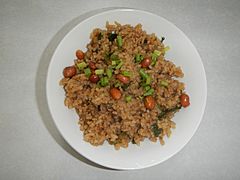Kiampong facts for kids

Kiampong from Manila
|
|
| Alternative names | kiampung, kiam pung |
|---|---|
| Course | Main dish |
| Place of origin | Philippines |
| Serving temperature | Hot |
| Similar dishes | sinangag |
Kiampong, also known as kiampung, is a special Filipino glutinous rice dish. You can think of it like a tasty rice casserole! Its name comes from a Chinese dialect called Philippine Hokkien. In this language, "kiâm-pn̄g" means "viand & rice," which perfectly describes this hearty meal. It's a very common and traditional dish for Chinese Filipino families, often enjoyed during special gatherings or everyday meals.
What is Kiampong?
Kiampong is a delicious and filling rice dish that combines meat, vegetables, and sticky rice all cooked together. It's known for its rich flavors, which come from a special sauce similar to Philippine adobo. This dish is a great example of how different cultures, like Chinese and Filipino, can blend to create unique and wonderful food.
A Taste of History
The history of Kiampong is tied to the long-standing connection between Chinese and Filipino cultures. Over many years, Chinese immigrants settled in the Philippines, bringing their traditions and recipes with them. They adapted their cooking to local ingredients, and dishes like Kiampong became a beloved part of Chinese Filipino family meals. It's a dish that tells a story of heritage and shared traditions.
How is Kiampong Made?
Making Kiampong usually involves two main cooking steps. The goal is to make sure all the flavors mix well with the rice, creating a super tasty meal.
Key Ingredients
The main ingredients for Kiampong often include:
- Meat: Usually pork, cut into small pieces.
- Sausage: Chinese sausage is a must for its unique flavor.
- Sauce: A mix of garlic, soy sauce, vinegar, sugar, and ground black pepper. This creates a savory and slightly sweet base.
- Rice: The star of the dish is glutinous rice, which becomes wonderfully sticky and chewy when cooked.
- Vegetables: Many recipes add veggies like mustard greens or root crops such as taro. These add texture and extra nutrients.
Cooking Steps
First, the meat and Chinese sausages are cooked in the special sauce. This is done until the meat is tender and has soaked up all the delicious flavors. Think of it like making a mini-stew!
Next, this flavorful meat and sauce mixture is added to a pot with the glutinous rice. Everything is mixed very well so that the rice can absorb the sauce as it cooks. The whole pot is then cooked, often by steaming or simmering, until the rice is perfectly done and sticky.
Before serving, Kiampong is often topped with crunchy toasted nuts and crispy shallots. These toppings add a wonderful texture and extra burst of flavor, making each bite even more enjoyable.

